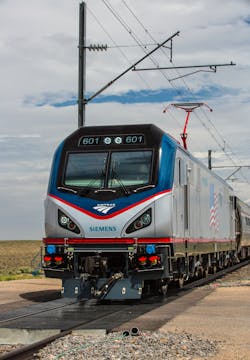Improving Existing Transportation Infrastructure Can Have Big Impact
The United States is faced with a unique challenge. No other country in the world is competing and winning with machines or technologies that are even one-third the age of our national infrastructure. Right now, the U.S. is equipped with roads, bridges and ports from more than 100 years ago and pipes and rail lines from the 19th century. However, there is enormous opportunity to make much-needed improvements to our existing transportation and power infrastructure that can more effectively move people and goods, provide more efficient power distribution in urban cores and enhance the mobility and productivity of entire regions.
By leveraging new software and technologies to help bolster our current, physical infrastructure, we're helping to create a competitive advantage in the 21st century global market and to increase economic growth in America’s cities. The Business Roundtable, an association of CEOs of leading U.S. companies, is calling this concept “hybrid” infrastructure, or the integration of IT with traditional infrastructure. Integrating the use of software into a city transportation system or automating a city’s power grid can simplify modernization without requiring cities to completely rebuild.
In this year’s American Society of Civil Engineers Infrastructure Report Card, no mode of transportation in the U.S. was graded better than a “C+.” Transit earned a “D,” rail garnered a “C+,” and roads were given a “D.” This means our transportation systems have a long way to go and clearly there are significant opportunities for improvement.
As world population expands and urban areas become more dense — 2008 marked the first time more people lived in cities than rural areas — it's not feasible to build our way out of public transportation challenges. Some systems, like the subway in New York, already run beyond capacity and it's physically impossible and extremely expensive to lay additional lines in the city.
This is where the Business Roundtable’s notion of “hybrid” infrastructure comes into play. Without having to completely rebuild transportation systems, technology can help address some of our nation’s more complex transportation challenges.
Big Systems Making Big Strides
While making some progress, the transportation sector must continue to leverage technology to help improve existing infrastructure. Other industries like telecom surge ahead, yet few transportation systems are fully automated. Already, U.S. cities and mobility providers are seeking out new technology to improve their systems without expensive installations or complete physical overhauls. The Metropolitan Transportation Authority (MTA) in New York recently upgraded the world’s largest train control system which supports NYC subways using Automatic Train Supervision (ATS) technology. ATS provides fully automated traffic control, wayside signaling, automatic vehicle identification and integrated voice and data communication. This is the largest ATS project in the world controlling 172 stations, 50 interlockings, 49 Central Instrument Rooms (CIRs), 108 miles and track and 220 simultaneous trains in rush hour.
And passenger rail operators are also leveraging software to deliver improved service along heavily-traveled routes. Amtrak, the largest passenger rail operator in North America, has commissioned 70 new electric locomotives for the Northeast and Keystone Corridor fleet. These advanced technology locomotives will be manufactured by Siemens in Sacramento, Calif., and are designed for easier maintenance, will improve energy efficiency through a regenerative braking system that will feed energy back into the power grid and will enhance mobility for the people, businesses and economy of the entire Northeast region.
Size Doesn’t Matter
It’s not just big systems and large cities that realize the need to improve their infrastructures. Small and mid-sized cities are upgrading their mobility systems as they see their city centers grow and transportation needs grow with them. The city of Tyler, Texas was experiencing growth in its commercial district, but citizens were frustrated with the increasing amount of traffic congestion created by the economic development. Instead of a hardware solution that may have resulted in construction and additional traffic delays, Tyler installed a traffic control solution in their existing infrastructure to coordinate traffic signals real-time based on current traffic patterns. Since the traffic control software was installation, the city has reduced travel time by 22 percent and delays by 49 percent. These savings amount to over $1.6 million in savings for Tyler drivers.
San Antonio VIA Metropolitan Transit is already experiencing a 20 percent reduction in travel times for its bus riders thanks to newly installed software used as part of their new bus rapid transit (BRT) system. VIA was first in the U.S. to install a transit signal priority (TSP) solution using “virtual” GPS-based detection zones for its transit vehicles. This approach was cost-effective and also avoided any construction delays. The TSP software allows the VIA Primo bus fleet’s on-board computer to automatically request green lights when the bus is behind schedule, subsequently improving travel time and getting riders to their destinations on time.
These efficient technology improvements are also spanning various modes of transportation, including light rail. In Portland, Ore., the city’s transportation authority TriMet is expanding its light rail transit line. Instead of installing a typical energy storage system to power its system, TriMet chose Siemens to install a more sustainable and energy efficient storage technology. The Sitras SES solution is the first energy storage unit of its kind in the U.S. and is unique in its ability to capture energy created during the rail car’s breaking and re-use it to stabilize voltage on the line or move to energy savings mode to store power until it is needed again. The storage unit can save up to 500,000 kWh annually, enough to power 44 home air conditioners running non-stop for a year.
Software, Everywhere
New software can make improvements across almost any infrastructure system. Grid operators can install software in their control centers that will help keep the power on during storms or other emergencies without having to build new substations or power lines. PJM Interconnection is the largest power grid operator in the U.S. The company supplies electricity to more than 58 million customers in Pennsylvania, New Jersey, Maryland, and other states. The utility distributes the electricity produced by more than 1,300 power plants to regional network operators. If this supply backbone were to break down, the customers of the local utility companies would literally be left in the dark.
In order to prepare its grid more effectively to deal with extreme weather events, the grid operator installed the world’s most advanced energy management systems from Siemens in November 2011. The system is currently without parallel in the U.S., since it employs two control centers instead of just one. The control centers support each other in everyday operation. However, if one of the centers should break down in an emergency, the other one can continue to control operations on its own.
Cities can retrofit older facilities using software that saves energy during peak demand times of the day. Opened June 2007, Dell Children’s Medical Center of Central Texas is one of the largest children’s hospitals in the state. It is also the world’s first healthcare facility to achieve the coveted LEED (Leadership in Energy & Environmental Design) Platinum Certification for New Construction, the highest level of green certification a building can obtain. At the heart of the facility is an advanced building automation system that integrates numerous facility systems and devices, helping the facility achieve its LEED certification. The efficiency measures in place at the Medical Center can save enough power to fuel the equivalent of approximately 1,800 homes in Austin, Texas.
There is no denying the need exists to build new physical infrastructure. But, technologies exist today that make immediate improvements to these rapidly growing economic hubs. “Hybrid” infrastructure provides cities a way to encourage economic growth, resiliency, efficiency, and better quality of life for its citizens.
Terry Heath is the president of Siemens Mobility and Logistics Division in the United States
About the Author

